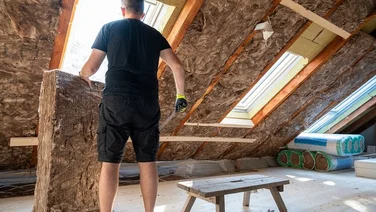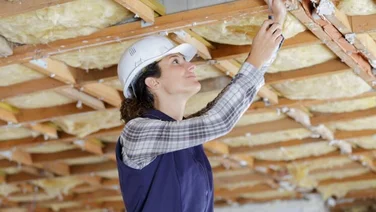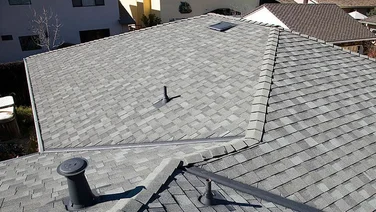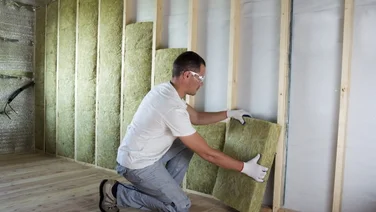- How much does UK spray foam insulation cost?
- Does spray foam insulation save money?
- What is the downside to spray foam insulation?
- How long does spray foam insulation last?
- Spray foam insulation cost per square metre
- What factors affect the cost of spray foam insulation?
- Are there any government grants for spray foam insulation?
- Who’s eligible for the ECO scheme?
- On average, spray foam insulation costs between £20–£50 per square metre (m²)
- Spray foam insulation costs range from £2,500–£4,075 for a three-bedroom property
- You can save up to 50% on your energy bills with spray foam insulation
The UK housing market has an insulation problem – with roughly two-thirds of homes being rated a D or below in their Energy Performance Certificate (EPC). These low ratings are causing two major issues across the UK: high carbon emissions and expensive energy bills.
If you want to protect your home against increasing energy bills, it might be worth reading our spray foam insulation guide.
Better yet, you can find the best deals on spray foam insulation by simply popping a few details in this quick form. Once we have some key information, we’ll put you in touch with our trusted insulation installers, who will provide you with their best insulation deals.
But for now we will detail the costs of spray foam insulation, who is eligible for money saving schemes, and look also at the benefits and potential risks.
Get free spray foam insulation quotes
Answer a few quick questions, and our trusted installers will send you bespoke spray foam insulation quotes – for free.

How much does UK spray foam insulation cost?
Spray foam insulation is a more expensive option than its fibreglass counterpart, typically costing around £2,500 to £4,075 for a three-bedroom semi-detached property. That often depends on the type of spray foam and size of the wall cavity.
If you’re thinking this is pretty pricey, you’re right. Spray foam is usually more expensive than other types of home insulation, partly because it’s more effective at locking in heat.
It does come with a number of potential risks that you should be aware of before purchasing. These include potentially making your home more difficult to sell, and impossible to mortgage or remortgage. You can read how it could also affect the structural integrity of your home and impact the environment in our guide on spray foam insulation.
Spray foam insulation costs £20–£50 per square metre – though this will depend on how thick it is. To give you an idea of how much spray foam insulation will cost for your property, we’ve taken a median price of £35 per square metre, and outlined just how much homeowners would have to pay to insulate different types of properties.
| Property type | Average property size (m²)* | Average cost of 100mm-thick spray foam |
|---|---|---|
House | 97.5 | £3,412.5 |
Bungalow | 76.5 | £2,677.5 |
Flat | 41.5 | £1,452.5 |
Maisonette | 78.5 | £2,747.5 |
*Figures from the ONS 2023
Remember that you’ll also have to take labour costs into account, which can vary depending on the amount of work required.
Most tradespeople will charge a daily rate of around £150–£200 for installing loft insulation. However, the installer might have to carry out additional jobs, such as electrical wire relocation or loft boarding, so you can expect additional expenses such as:
- Electrical costs: £150–£400
- Removal costs: £200–£600
- Decorating costs: £100–£300
Some people try to reduce these costs by trying DIY spray foam kits or expanding foam cans, but we wouldn’t recommend doing this. Not only could you damage your property, but you could also risk your health and the environment.
Want to see how much spray foam insulation will cost you? Pop a few details in this quick form, and our trusted suppliers will be in touch with free quotes for you to compare.
Does spray foam insulation save money?
Well, installing it in a three-bedroom semi-detached house can save homeowners as much as £540 on their energy bills each year. But remember that this will vary according to the type and size of each property.
Although spray foam is the most expensive type of insulation, you certainly get what you pay for. The average R-value (a calculation to give a value to a material’s thermal resistance) of spray foam insulation is between 5.6 and 8 per inch – much higher than other forms of insulation – which means homeowners will quickly make their money back through savings on their monthly energy bills.
Some studies have shown that spray foam insulation can save you as much as 50% on energy bills when compared to traditional home insulation products.
Can I install spray foam insulation myself?
You can apply spray foam insulation yourself, but it’s rarely worth it because of all the specialist equipment and training you’ll need to have. Applying it too thickly or thinly can reduce its effectiveness, and in some cases cause substantial damage to your home.
It’s also possible that poorly applied spray foam insulation can cause a long-lasting smell that is very difficult to get rid of.
Additionally, you’ll need to make sure you wear the right protective gear when applying spray foam insulation because it can damage the lungs and cause painful skin irritation.
Your best bet is to hire an experienced professional to apply your spray foam insulation to avoid these potential issues.
Get free spray foam insulation quotes
Answer a few quick questions, and our trusted installers will send you bespoke spray foam insulation quotes – for free.
What is the downside to spray foam insulation?
Spray foam insulation is considerably more expensive than fibreglass — up to three times more expensive sometimes.
It’s also a pain to remove from properties as the material will effectively glue itself to your roof. This can be an issue if you’re trying to remove it from older timber structures, and the process of doing so can cause damage.
Spray foam can sometimes increase condensation within a property too, which has the unfortunate effect of damaging things like timber structures. This makes the property more difficult to get a mortgage for, and it can even reduce the value of your home because the structural integrity has been affected.
How long does spray foam insulation last?
Both types of spray foam (open-cell and closed-cell) can stand the test of time, typically over 80 years due to it being made of polyurethane. Closed-cell is more rigid and typically lasts longer, but open-cell will last for decades too if properly installed.
Spray foam insulation cost per square metre
The cost of closed-spray foam insulation is usually between £20–£50 per m², and £30–£70 per m² for open-cell.
Just for reference, closed-cell spray foam is denser and provides structural rigidity, keeping moisture out too. It insulates better but is less breathable and flexible. Open-cell spray foam expands more and has better sound proofing, but is generally less rigid and offers less structural integrity.
To compare to other types of insulation, loose-fill insulation costs around £7.50 per m², blanket insulation will set you back roughly £5 per m², and a thermal foil layer will be about £3 per m².
What factors affect the cost of spray foam insulation?
The cost of spray foam insulation depends on a few things, including the:
- Size of the property you want to insulate
- Thickness of the foam
- Type of insulating spray foam (open or closed cell)
- Amount of time it takes to install

Are there any government grants for spray foam insulation?
The main government grant for insulation available to Brits is the Energy Company Obligation (ECO). The 2022-2026 scheme, ECO4, began in April 2022.
Under the ECO4 scheme, a number of obligated energy suppliers work with local companies to install energy efficiency measures, such as loft or wall insulation, in UK homes. Better yet, these energy suppliers fund the installation, which means eligible homeowners won’t have to pay a penny.
Who’s eligible for the ECO scheme?
According to Ofgem, you’ll be able to take advantage of the ECO4 scheme if you are a core group customer from scheme year nine onwards under the Warm Home Discount Scheme, or you receive at least one of the following benefits:
- Armed Forces Independence Payment
- Attendance Allowance
- Carer’s Allowance
- Child Benefit
- Constant Attendance Allowance
- Disability Living Allowance
- Pension Guarantee Credit
- Income-Related Employment and Support Allowance (ESA)
- Income-Based Jobseeker’s Allowance (JSA)
- Income Support
- Industrial Injuries Disablement Benefit
- Mobility Supplement
- Personal Independence Payment
- Severe Disablement Allowance
- Tax Credits (Child Tax Credits and Working Tax Credits)
- Universal Credit
You might also be eligible for the scheme if you are living in social housing with an EPC rating of E, F, or G.You might also like: A Guide to Government Grants for Insulation
What’s the return on investment from spray foam insulation?
It takes between three and nine years to break even on spray foam insulation – but this will depend on the type and size of the property.
We’ve listed the break-even point of spray foam insulation for different properties below:
| Property type | Average cost for 100mm-thick spray foam | Average break-even point |
|---|---|---|
House | £3,412.5 | 8.9 years |
Bungalow | £2,677.5 | 7 years |
Flat | £1,452.5 | 3.8 years |
Maisonette | £2,747.5 | 7.2 years |
What’s the cheapest type of property insulation?
If you’re looking to insulate your home on a budget, the best option is usually blankets/rolls of fibreglass. Not only is this material affordable, but it is also quite effective – although, you won’t feel the benefits as much as you do with spray foam insulation.
Thinking of opting for blanket insulation? It’ll cost you around £5 per m², on average. To give you a better idea of how much this would cost you overall, check out the table below.
| Property type | Average cost for 270mm-thick blanket insulation |
|---|---|
Detached house | £1,200 |
Semi-detached house | £500 |
Terrace | £400 |
Bungalow | £600 |
*Figures from Checkatrade 2024
Fibreglass is easy to install and comes in rolls or batts (flat panels). Although it’s cheap, bear in mind that there can be some issues with installing it, mainly because it doesn’t neatly fit in small spaces or around obstacles.
The cost of spray foam insulation is often one thing that puts people off the idea. Want to learn more? Check out our page on 5 Key Problems With Spray Foam Insulation and How To Solve Them.
Summary
- Spray foam insulation is generally the most expensive type of insulation.
- You’ll spend £20–£50 per m² for open-cell spray foam, and £30–£70 per m² for open-cell.
- It’s effective, but comes with a host of potential problems you should be aware of.
- Spray foam can make it more difficult to sell your home, or get a mortgage/remortgage a property.






